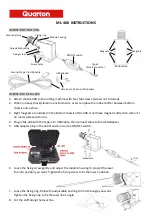
The ground path for high frequency signal return currents is shown in the probe architecture figure. (See
Series TriMode probe input architecture
on page 4.) The probe ground path is continuous and along the following path:
• Extends from the DUT ground vias connections at the probe tip input
• Through the probe tip ground path
• Through the TekFlex connector ground spring contacts
• Along the main cable coaxial shields into the probe comp box
• Through the probe amplifier circuit board ground plane inside the probe comp box, and
• Through the TekVPI interface to the host oscilloscope ground
A TriMode tip requires a short DUT ground reference for making low noise single-ended probe measurements.
Although two ground via connections are available on the probe tip input, a single ground via wire connection is usually
adequate for making single-ended measurements of both the A and B input signals or a common-mode measurement, all of
which are ground referenced.
If only one single ended signal will be connected to the probe, the user has the choice of connecting the A input to the
signal and the B input to ground, or connecting the A input to the signal and the ground input of the probe to the ground
input of the DUT. In this situation, Tektronix recommends using A-B mode with the B input connected to ground. Reasons for
this recommendation include that with the B input left disconnected, there is a possibility of an interfering signal coupling into
the input of the probe and distorting the measured signal acquired on the A side.
A second reason for using A-B vs. A-ground is that it is often more convenient to connect the differential inputs of the probe
to a device and keep the wire lengths short. The ground connections of the probe are set back from the tip and may not be
as convenient to connect to a DUT with tightly spaced test points.
The optional accessory P77BRWSR is a variable-spacing probe tip which operates in Differential Input mode only. The
P77BRWSR Browser probe tip does not have a physical ground connection at the probe tip; but the differential
measurement process itself provides a high frequency virtual ground connection between the A and B signal input pins. A
low frequency ground connection is optionally available at a square-pin socket on the browser probe tip housing.
The comp box receives power and control signals from the oscilloscope through the TekVPI interface. The TekVPI interface
is an intelligent probe connection that includes many automated and manual control features. For example, there is a probe
S-parameter memory in the comp box that stores high frequency characterization data for the probe signal path.
The downloaded S-parameter data for a probe and attached probe tip is used by the oscilloscope to generate a DSP
correction filter for optimum measurement fidelity. Because this S-parameter data is unique and serialized for each probe
and probe tip, it only needs to be downloaded once to an oscilloscope.
Automatic probe tip type identification is another example of the intelligent operation of the TDP7700 Series probes. When
no probe tip is attached to the TekFlex connector of a TDP7700 Series probe, the TekFlex probe tip interface power is
disabled. When a probe tip is attached to the TekFlex connector, the attachment is detected by the probe and the probe
queries the probe tip memory to check for a valid identification header. If a valid probe tip type is verified by this TekFlex
data interface query, the probe tip power is enabled until the probe tip detachment is detected.
When probe tip power is enabled, an LED is activated on the probe tip, indicating that the TekFlex interface and attached
probe tip appear to be operating properly. If the probe tip type attached to the TekFlex connector is a browser probe tip, the
probe tip automatically detects the current tip spacing and communicates that information to the oscilloscope.
There are several calibrated tip spacing regions defined for the browser tip, which affect the frequency response of the
browser tip signal. Wider tip spacing tends to degrade the browser tip frequency response. The oscilloscope uses the
current tip spacing region information to select the optimum DSP correction filter for use with the browser tip measurements.
Input architecture with the P77C292MM SMA adapter
The P77C292MM adapter is a passive probe adapter; there are no active components within the adapter. It is intended to
connect the TDP7700 series probes to 50 Ω RF test points.
Theory of operation
TDP7700 Series TriMode™ Probes Technical Reference
6















































